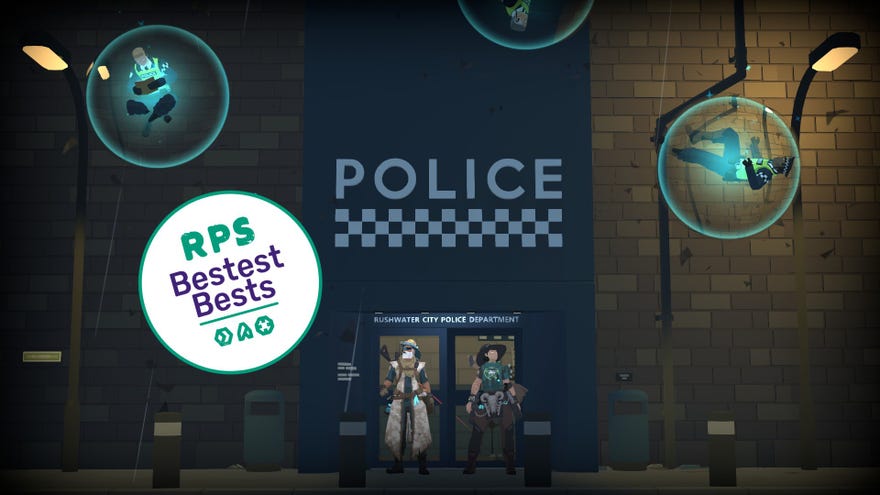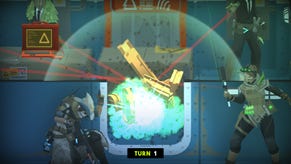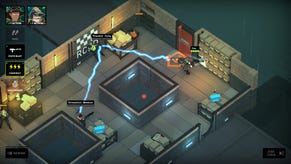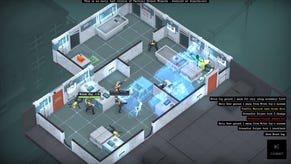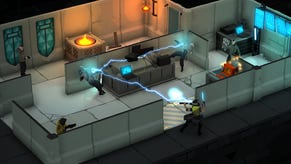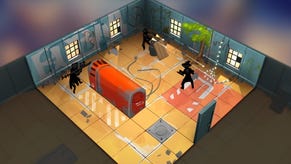Tactical Breach Wizards review: humour, heart, smarts and playfulness conjure up an instant genre classic
When god breaches a door, he also blasts you through a window
Tactical Breach Wizards is a tactics game for people that don’t like tactics games. Magically, it’s also a tactics game for people who love them like nothing else. It’s permissive and demanding; playful and tense. Its globe-spanning plot covers conspiracies, PMCs, and brutal theocratic dictatorships. It also features a traffic-summoning warlock named Steve wearing a hi-vis robe. It’s finding that one absolutely, perfectly ridiculous XCOM turn, every turn…and at the same time knowing it’s absolutely, perfectly fine if you don’t. In short: it’s one of the most enjoyable tactics games I’ve ever played, and the only tactics game with a pyromancer so rubbish he relies on making his enemies pass out from heatstroke.
As all critical operations must, Tactical Breach Wizard’s story begins with a door getting blasted open. Some bad dudes have a hostage, and Navy Seer are here to extract. The Druid Mafia’s shrublord is wearing a ghillie suit. That’s despite him - as chrono-crumpling Liv Kennedy points out to single-second soothsayer Zan Vesker - already being a tree. He’s also tough, so Zan’s rifle isn’t enough to take him down a single turn. Liv's left wide open, so Zan'll have to scry the outcome to learn whether she can dodge the shot. In the same way, you’ll be able to foresee the consequences of every action before committing to it. And if you decide later it was a terrible mistake, you can rewind - one move at a time - to the start of the turn.
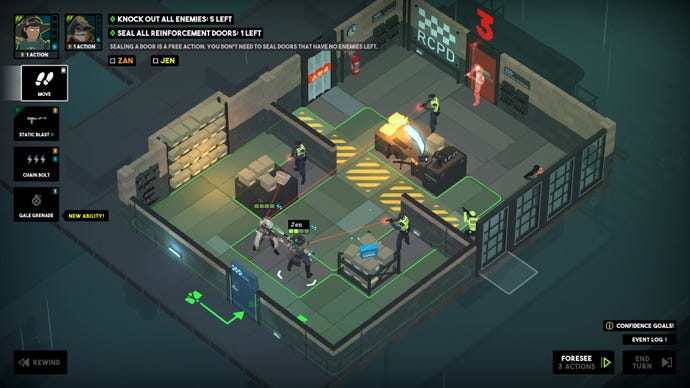
Zan saves the hostage, but things get complicated for Liv, and we’re whisked away from the scene to meet storm witch and private investigator Jen Kellen, getting chewed out for butting in on police business. It doesn’t take long before the office suddenly catches fire - a fact Jen brings up to the cop the same way you might tell someone their pasta’s boiling over. A scrap with the inept pyromancer leads to a Jen and Zan reunion, a police shootout, and eventually a conspiratorial rabbit hole that takes them to the other side of the planet.
I lack those rewind powers I mentioned, so I’ll first have to own up to a mistake I made calling TeeBeeDubs missions “eminently solvable, room-by-room discrete puzzles” when I wrote about the demo. You should still read it, because I used up all my best window gags there, but that isn’t really how things work. There are still optional challenges and side stories that hew closer to set puzzles with an ideal - if not sole - solution. But, once you’ve expanded your team and unlocked a few abilities, things become much more improvisational. Have Zan grab some intel for a mana boost, chuck a few extra-action grenades at Jen, and you can work out how she’s going to spend them once she’s already ridden her broom to the far window to seal a reinforcement door. A finished mission means the feeling of having hit upon just one perfect outcome among many. And, even then, having clambered up to that point via your own personal chain of joyous, spur-of-the-moment spell-slinging nonsense.
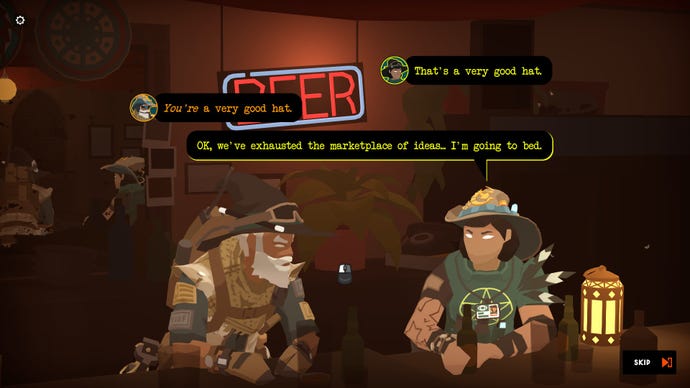
Crucially, this permissive playfulness is still anchored by satisfying, tricky goals and the need to juggle multiple priority threats each turn. You’re an untangler, really. Jen absolutely needs to blast that heavy through a window before he takes out Zan, because Zan can’t stay in cover when that other baddie has a magic-nullifying beam bead on Rion, who needs to transform into a dog so he can bite that second heavy, making him rabid so he attacks the shotgunner, whose a big threat to… and so on. Never have so many proverbial micro-USB cords been so gratifying to pick loose from their medusa-hair prison.
This is all supported by optional objectives. Finish in three turns. Defenestrate (verb: yeet from window) four enemies. Deal eight knockback. The explicit reward is a resource named confidence you can use to buy new outfits for your team. The flashier your wizards act during missions, the swankier outfits they can pull off. They’re presented as voluntary challenges, described as “intended for players finding basic completion too easy”. But I’d say this is the game selling itself short. What they really are is creative writing prompts, in the John Wickensian sense of pencil usage; little inspirational flourishes I’d use to clue myself into what was possible. Once you know a single-turn victory is theoretically doable, your brain starts reverse engineering scenes for crimes so cool they don't even have names for them yet.
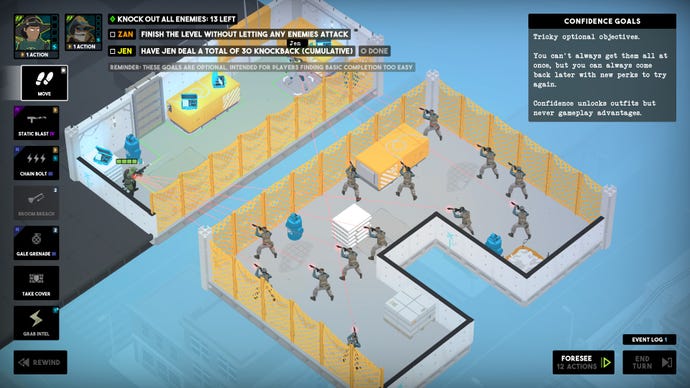
And yes, this does all mean that TeeBeeDubs isn’t a difficult strategy game to progress through, but the even the ability to skip levels entirely is besides the point. Such a bulging bag of rule-shattering wiz-tricks mean you’ll likely never even be tempted. It’s wizard 101: you’re already dangerously powerful enough to whisk up tempests, the game is to harness it with enough finesse to make soufflé.
That’s not to say the classic joy of stretching each action point as far as possible is absent, just that there’s always room to get weird for the sake of showing off. Just like those outfits, it’s about self expression. It employs the rule of cool to make you want to come up with the cleanest, most elaborately efficient plays possible. This way, it incentivises you to use your entire toolset without relying on punishing difficulty. Normally, for a game to make me want to dig this deep into my bag of tricks would require enormous pressure. A sacrificial Into The Breach play. Being swarmed by a seemingly insurmountable force in XCOM 2. Here, nine out of ten corners I felt backed into were corners I gladly teleported to myself. Mostly, I just felt let loose in a toy shop.
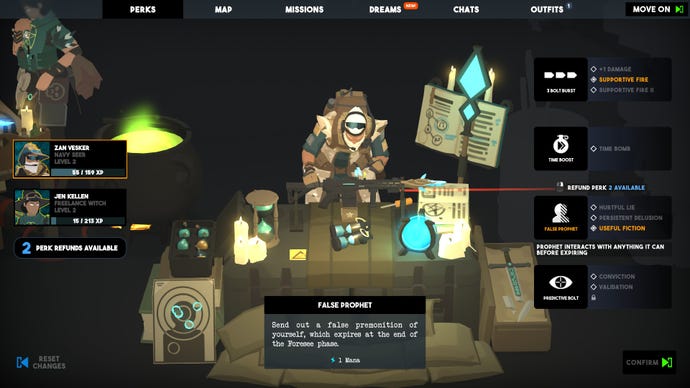
For context, I’m not always tempted by intrinsic bits, especially if I’m on the review embargo clock. Here, I found myself replaying turns just because I figured my rizzed-up wizzes would prefer not to get hit even once, if they could help it. You can end a mission with your team bruised and battered with no consequence for a majority of the maps, and you'll still start the next healed up. Still, even when contorting itself to offer absurd flexibility, the game never puts its backbone out, nor breaks its spine altogether. The challenge escalates through new wrinkles like alarms, locked doors, enemies that are rarely just 'this guy again but killier', and those that can sometimes break the rules as powerfully as you. An evil priest that retaliates each time you attack his allies, but won't defend himself. A medic that can revive the dead. A riot-shielded heavy with a gasmask that immunises them against your special knockback juice. If the core rules of the game are its language, the abilities of you and your foes are poetics and pun-stuffed punchlines both.
When we talk about games feeling ‘human’, it’s usually an attempt to capture something resonant or fearless or otherwise authentic about the stories they tell. Tactical Breach Wizards nails this, by the way. The writing quickly evolves from "this is funny" to "no, but this is actually really funny". Then it evolves again from "I’m genuinely getting a kick out of spending time with these weirdos" to "is somebody throwing onions out of windows in here?". Each teammate even has an optional anxiety dream missions where, say, Jen teams up with her own subconscious to hash out her insecurities. But actually I found TeeBeeDubs’s hidden profundity in, of all things, a menu screen.
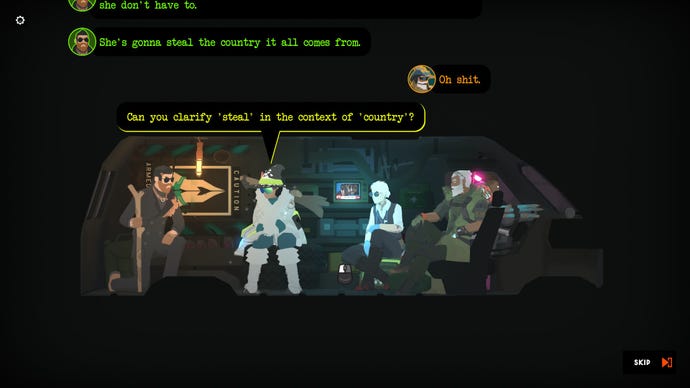
Each of the five wizzes you’ll eventually rope in to your party of wildly competent failures has an incredibly distinct skillset, and as they gain experience through missions, you’ll unlock perks that augment their standard abilities. A few perks are more mundane, although even an extra point of damage for Zan’s shot ends up being transformative. By and large though, reader: this shit is wild. I’d gaze at the perk screen, joyfully paralysed, trying to envision all the ridiculous scenarios that, say, Zan’s spectral clone now being able to interact with panels and doors could result in. You can refund perk points whenever you feel like it, but this conundrum is my experience with the game distilled. A pre-emptive fear of missed opportunities, made sweet by a grinning, glazed-over sense of exciting possibilities. Like being alive. With better hats.
It’s not free of issues. Necro-surgeon Dessa Banks has an ability that’s so universally useful I ended up anchoring my plays with it for a good stretch, and it wasn’t even the one where she can resurrect people by shooting them. The ending missions prioritise story setpieces over the final exam gauntlet I was hoping for, and I found myself drifting toward autopilot even a few missions before those. There’s probably one too many fat smears of frosting in the conspiratorial layercake plot to comfortably keep track of your first time through. But the fact I’m even excited about a second playthrough of a 15 hour game I played for work should hopefully convey something. This very moment, I keep diving back in to check details and grab screens, and end up replaying entire missions. There’s more! Survival maps. Optional puzzles. The same level editor the developer has, with the option to share your maps with others online. Hard mode. Is this all window dressing? Maybe. But man, what an absolute treat of a window. Do say "hi" on your way down.
This review is based on a review build of the game provided by the developer. Suspicious Developments' Tom Francis has written for RPS.